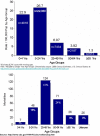How I treat influenza in patients with hematologic malignancies
- PMID: 20009037
- PMCID: PMC2826758
- DOI: 10.1182/blood-2009-11-255455
How I treat influenza in patients with hematologic malignancies
Abstract
The 2009 H1N1 influenza pandemic has heightened the interest of clinicians for options in the prevention and management of influenza virus infection in immunocompromised patients. Even before the emergence of the novel 2009 H1N1 strain, influenza disease was a serious complication in patients with hematologic malignancies receiving chemotherapy or undergoing hematopoietic cell transplantation. Here we review the clinical manifestations of seasonal and 2009 H1N1 influenza and discuss current diagnosis, antiviral treatment, and prophylaxis options. We also summarize infection control and vaccination strategies for patients, family members, and caregivers.
Figures



References
-
- Domínguez-Cherit G, Lapinsky SE, Macias AE, et al. Critically ill patients with 2009 influenza A(H1N1) in Mexico. JAMA. 2009;302(17):1880–1887. - PubMed
-
- Swine influenza A (H1N1) infection in two children—Southern California, March-April 2009. MMWR Morb Mortal Wkly Rep. 2009;58(15):400–402. - PubMed
-
- Centers for Disease Control and Prevention. 2009 H1N1 Flu: International Situation Update. [Accessed October 17, 2009]. http://www.cdc.gov/h1n1flu/updates/international.
-
- US Centers for Disease Control and Prevention. Percentage of Visits for Influenza-like-Illness Reported by Sentinel Providers 2009-2010. [Accessed January 21, 2010]. http://www.cdc.gov/flu/weekly/weeklyarchives2009-2010/data/senAllregt46.htm.
Publication types
MeSH terms
Substances
Grants and funding
LinkOut - more resources
Full Text Sources
Other Literature Sources
Medical

